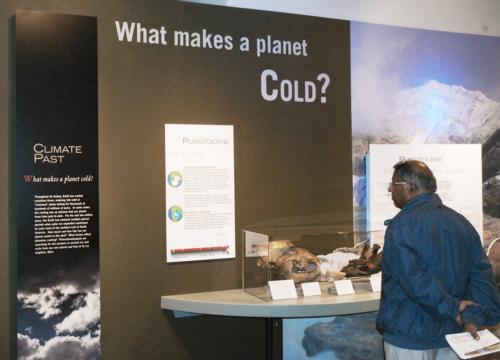
News
Cambridge Residents Slam Council Proposal to Delay Bike Lane Construction

News
‘Gender-Affirming Slay Fest’: Harvard College QSA Hosts Annual Queer Prom

News
‘Not Being Nerds’: Harvard Students Dance to Tinashe at Yardfest

News
Wrongful Death Trial Against CAMHS Employee Over 2015 Student Suicide To Begin Tuesday

News
Cornel West, Harvard Affiliates Call for University to Divest from ‘Israeli Apartheid’ at Rally
Museum Hosts Climate Exhibit
Installation by Harvard scientists forecasts stormy future

A new exhibit on climate change at the Harvard Museum of Natural History highlights the work of Harvard scientists who say that devastating hurricanes, like Katrina and Rita, may be everyday occurrences in the near future.
Spearheaded by Professor of Earth and Planetary Sciences Daniel P. Schrag and 10 other Harvard-based scientists, the exhibit is co-sponsored by the Harvard University Center for the Environment, of which Shrag is also the director.
The exhibit, “Climate Change: Our Global Experiment,” opened its doors to the public on Oct. 1, and presents years of scientific research on global climate change. Schrag and the other scientists used geochemistry to analyze past climatic conditions and compare them to the present.
The exhibit, Schrag said, “gives you a little bit of a different perspective. [It] looks at climate change as a planetary experiment.”
Schrag said that because the emission of carbon dioxide is a “human experiment,” studying greenhouse gases should be treated like studying the effects of an experiment instead of a natural occurrence.
While the exhibit itself invites visitors to draw their own conclusion, Schrag has already developed a somewhat grim prognosis.
While he said that scientists do not yet have all the answers, he suggested that the increase in CO2 in the atmosphere in recent decades could have dire consequences on the global environment, such as warmer weather, which would lead to more virulent hurricanes.
Schrag’s research has shown that human survival could come into question as unstable and unpredictable weather conditions plague the planet.
But Schrag’s findings are not without controversy.
Some scientists, such as Willie Soon, an astronomer at the Harvard-Smithsonian Center for Astrophysics and a senior scientist at the Marshall Institute—which is funded by Exxon Mobile and other private interests—suggest that the current climatic change is a natural phase in climate history, rather than induced by carbon emissions.
But Schrag disagrees with this line of thought, which in recent years has countered environmentalists’ claims of permanent environmental degradation. “We can prove, using modern data, that the increase [in C02 concentration] is not part of a natural cycle,” Schrag said.
Schrag also said that for the last 800,000 years or more CO2 concentration did not exceed 300 parts per million. Today, the concentration is at 380 and “by the end of the century it will be between 900 and 1,000.”
Schrag also insisted that there is “no single solution to climate change,” and that solutions would be costly because of our reliance on fossil fuels.
Schrag did offer some suggestions, such as reducing carbon dioxide in the atmosphere by pumping it underground, which might help facilitate the carbon cycle, the earth’s natural means of drawing carbon out of the air.
Want to keep up with breaking news? Subscribe to our email newsletter.
